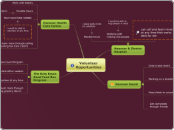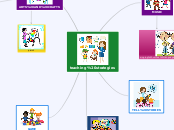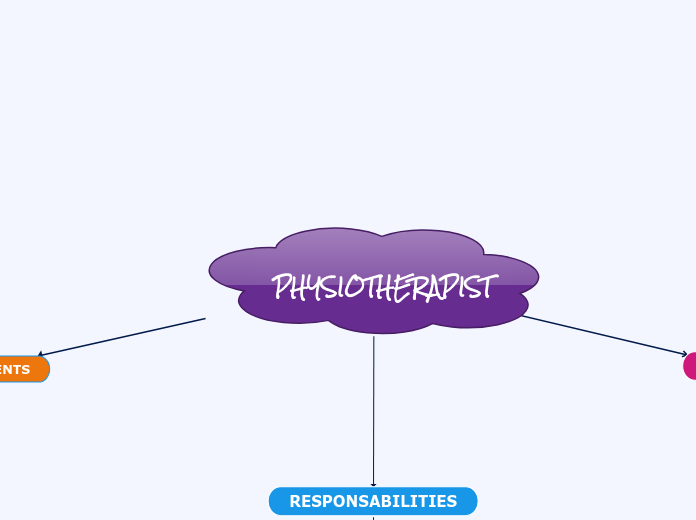Gamification Map
Gamification for Good
Behavior Change - Habit Formation
triggers loops
good games trigger effectively
progression loops -> percieved ability
engagement loop -> motivation
Fogg Behavior Model
trigger types
signal
facilitators
sparks
trigger timing
motivation and ability tradeoffs
Social Good Techniques
chance - creates interest in the same gamified system so can just be used to enhance to fun of the game
impact - shows just what good the game playing or site is doing for the world
ex practically green
Kukui Cup (Univ. of Hawaii)
competition works for social good because the pride in winning is wrapped up with the pride in doing good
uses competition to make students use less power
ex. CAPRI - parking relief sites
communal pressure - activates social norms as opposed to competition
monitoring
feedback and rewards
Examples: 4 Categories
Government
promotion of its policies and programs
customer service - interacts with voters, etc.
Motivational - lots of workers
Education
openbadges.org - virtual diplomas
challenge is to make sure it is benefitting education
Energy and Evironment
Recyclebank - earn points by recycling to redeem for rewards
OPOWER - uses peer pressure and neighbor experiments to encourage people to save energy
Health and Wellness
Superbetter - set up your own gamified system of self improvement
Zamzee - device that keeps track of how active you are; targeted toward low income teenagers; PBLs, rewards, etc.
Whats different about gamification for social good?
behavior change
should you get rewards for doing good?
inherent relatedness
Enterprise Gamification
Playbor - combination of play and labor
can use games to replace messed up motivation systems with ones that are more accurate, and more effective
have to be careful not to encourage cutthroat competition or "cracking the whip"
Game vs Job
types of job game motivation
type of skill: core skills, unique to a person skill, future skill
citizenship
gamification works well here with core skills
in role
gamification works well here with future skills
sometimes the game can take people away from their job
What Motivates People in the Workplace?
Fun (in the workplace)
eg. the face game, at zappos
Corporate (or other) Citizenship
Information
leaderboards and info about how to do better can motivate
Skill Development
Compensation - ie give you something for something you don't really want to do
Extrinsic
Design Choices
Case Study: Stack Overflow
incentivized working together, uses points and badges
First they asked "What Is Programming?"
how did they motivate people to do this?
website where you ask coding questions and answer them
Should We Gamify?
Potential conflicts
Structure
Meaningful Choices
are the target activites interesting?
derive value from encouraging behaviour?
or, make boring tasks interesting
emotional connections
skills that require more than a basic action
Taking Stock: Two Approaches
Feeling
draw on:
Game Design and Psychology
Experiences
Fun
Game Thinking (Deductive)
Meaning
Puzzles
Progression
Making Players Awesome
Doing
draw on:
Marketing and Economics
Incentives
Satsifying Needs
Game Elements (Inductive)
Status
PBLs
Rewards
Making Users Do Things
Design
6 Step Gamification Design Process "D6"
6 Deploy
deploy the appropriate tools; use the rights elements and structures
Gamification Pyramid
PBL
5 Don't forget the Fun
easy to miss when you are doing gamification, but can't be forgotten!
Why would someone want to do this? Is it REALLY fun?
protein folding - game site that actually allows players to help figure out new protein types
linked in progress bar - even this has a small amount of fun
fitocracy seems dedicated to making fun
4 Devise Activity Loops
structuring the core micro and macro level game aspects
Good games should have both types of loops
Progression Loops
one example
finally reach the end and you can look back and see your mastery
maybe boss fights periodically
then climbing and resting alternately
starts with onboarding, getting the player into the game
specific steps to achieve your objective, start to finish
Engagement Loops
a game Ive used an engagement loop in is Starcraft/ the ladder system makes you want to win, the action is playing the game to win, and the feedback is winning and seeing your rank improve
Action
Motivation
3 Describe
describe your players; what are they like, how can the system respond to them?
Barle Model of Player Types
What Motivates your Players?
eg. world of warcraft
players may need items
players need to find other players with specific skills
2 Delineate
what are the objectives that you want people to do?
what are the analytics? how do you measure these win states?
eg. volume
level of usage and engagement and what people are doing
eg. virality
rate at which people refer their friends
eg. DAU/MAU
daily average users/monthly average users
higher is closer to 1, people who visit the site are coming back more frequently
how often do people come back?
what are the success metrics? in gamification terms "win states"
Should be as specific as possible
eg. I want people to buy paper towels
eg. I want to find the best people to hire at this job
What do you want users to do?
1 Define
define your business objectives; what is this system designed to accomplish what are its goals?
Justify Objectives
Eliminate means to ends - eg badges are not a real objective for the business, just a stepping stone (and objective for the user)
List and Rank your possible objectives
What are your business objectives?
what are the ultimate goals?
eg. foursquare
influencer marketing
locating people that are influencers an d encouraging them to be an active participant with deals or badges or whatever
social sharing
increases value the more people that use it (concept in decentralization)
Design Thinking - ideas of how design should go into thinking about creating ANYTHING
iterative - expect not to get it right the first time; improving with each iteration; prototyping and playtesting
balance - between analytical and creative thinking; use abductive reasoning sometimes - inference from the best possible explanation
human centered - designed around people, specifically;come up with solutions for PEOPLE, not robots; useful, not just a set of objectives
purposive - everything should tie into the purpose you are going for
Motivational Design and Psychology
self determination theory - motivation spectrum - worst motivators to best
what leads to intrinsic motivation?
relatedness
connects you to something else
autonomy
feeling of control
not predetermined
self reliance
competence
feedback that makes you feel good
3- intrinsic
motivating in and of itself
2- extrinsic
4 - integration
complete alignment between my goals and the thing i'm doing eg. excersize
3 - identification
user can identify some motivation in doing the thing eg. learn math for business etc.
2 - introjection
take an external motivation and make it our own eg status
1-external regulation
forced to
1- amotivation
not motivated
Rewards can actually demotivate someone that would otherwise enjoy something intrinsically
the reward substitutes
reward types do matter:
performance contingent
if it is encouraging and fills you with a sense of accomplishment, its not
if the reward objectifies your accomplishments, it is demotivational
surprise rewards do not influence that much
tangible rewards substitute highly
usually happen with an activity thats "interesting"
studied examples:
teacher salaries
blood donating
day care pickup
creative things like drawing
2 Major Fields of Psychology
Cognitivism
Extrinsic Rewards
SAPS framework - its a higherarchy from the standpoint of the company rewarding their employees
Stuff
Power -
Access - will give us access to something more
Status - will make us cool
doing an action for something
Intrinsic Rewards
love something just to be doing it
Behaviorism
Dangers of Behaviorism
over-emphasis on status
hedonic treadmill
kill the rewards by making them so expected
if people only respond to a reward, they will change back when the reward is not there...
manipulation
Limits of Behaviorism
purely behaviorist approach seperates the person from their humanity
can lead to social problems like fascism etc.
Leaves out important things:
why do people like lotteries?
people might avoid something not to learn, but just so they don't get caught
Relevant Takeaways for Gamification
Reinforcement
Importance of Feedback Loops
can condition through consequences
Reinforcement through Rewards
Reward Structures
Reward Schedules
Variable
help make people addicted so not always a good thing...
brains love a sense of surprise
competitive/non-competitive
vs. other people makes reward variable
most interesting because brain cant recognize patterns
Fixed Interval
based only on time not amount of action
Fixed Ratio - every N number of times you take an action you get a reward
Continuous - get a reward every time
Different Types of Rewards - One Typology of Rewards
Cognitive Evaluation Theory
Contingency
5.4 Excersize:
The cruise reward for staying on the site is an intangible, unexpected engagement (arguably completion) contingent reward
performance-contingent
completion-contingent
engagement-contingent - get a reward just for starting
non-contingent - u get the reward no matter what
expected/unexpected
tangible/intangible
much of PBL Gamification is like this
5.3 Excersize
Game I played: Starcraft 2
One behavioral mechanism was the strategy forums that continually updated the new ways to approach the game, and reinforced the community through the elevation of better players through status and study.
eg. MLB Badges - why were fans so obsessed?
partly a behavioral feedback loop
eg. Farmville - Crops Withering over time creates an appointment mechanci
people had to habitually check in - very behavioral approach
Observation:
often different than what you think they will do
Look at what people actually do
Behavioral Economics
people make 'mistakes' consistently
confirmation bias
eg. power of default states - ie. opt-out vs opt-in
eg. loss aversion
thinking about what people actually do without the why
Conditioning
operant conditioning - feedback loop
consequences are important
stimulus plus response plus stimulus etc. = learning
classical conditioning - stimulus plus response for simple pavlovian conditioning
ring the bell for dinner - start salivating
Black Box Approach
we are conscious, don't worry about what goes on inside the head, only the behavior
Why?
People do things for stuff other than rewards
5.1 excersize:
task - get people to save their change in one place
4- remind them with updates and badges earned for successfully saving change
3- tantalize them with a goal that saving change can produce
2- make it easy for them to save change by providing examples, framework and a system
1- explain the benefits of saving change and being organized
Broad Gamification Introduction
Where Can Gamification Be Used?
Behavior Change
eg. Speeding
monitor that records liscence plates
used in stockholm
people who don't speed are entered into a lottery
fines go into a pool
fine people who speed
police monitors of speed give feedback
slows you down
causes behavior loop
Finance
Social Change
Sustainablility
Health
Internal
eg. Windows 7
localization problem
mind-numbing activity turned fun
found over 7,000 bugs
played for prestige and competition within complany
used gamification - language qualification game
productivity enhancment
crowdsourcing
using groups to attack a problem
for employess
External
eg. Club Psyche
relatively simple/big impact
results
sharing up
pagesviews up
mercandise sales up
visits to site up
integrates with the show it promotes
points and rewards
Sales
Marketing
Why Study?
not that easy or obvious
needs to be done relevantly and in context
needs to be done ethically
needs to be done well
link to aspects of how our minds work eg:
technology
focus on social networks and current tech
strategy
design
psychology
motivation
they are powerful tools
significant up and coming business practice
What is a Game?
J. Huizinga:
Concept: The Magic Circle
try to put the user in the magic circle
where the game matters, the rules matter, and it is another world
There is a circle or boundary that defines the game from the real world
Book: Homo Ludens argues that games and play are essential to what makes us human
incl. religion, government, justice etc.
Bernard Suits:
Voluntarily overcoming arbitrary obstacles
Elements
Lusory Attitude
think the game means something
player voluntarily follows the rules
Rules
Pre-lusory goal
way to win the game
took on Wittgenstein
Wittgenstein:
cannot define the boundaries
cannot define a game
examples
Zombies Run
more immersive experience than nike+
can involve your friends
can collect power ups
run from zombies
Nike+
still going out to run
connect with friends
establish goals get medals
In non-game contexts
non-game is anything other than the game for its own sake
eg. being healthy
eg. playing to learn something
eg. playing to get a job
eg. playing to encourage an action
game design techniques
how to "think" like a game designer
approaches to game design
some elements:
social graphs
avatars
quests or missions
levels
points
toolbox for designing games
History
2010 - Gamification takes off
Magazine Profiles
Books
TED Talks
2005 - Bunchball
2003 - Conundra
failed
2002 - on
Games for Change
teach systemic impact thinking
social impact games
eg. simulatinig the battlefield for the military
Serious Games Initiative
1980s
James Paul Gee book
Thomas Malone - MIT - What Makes Things Fun to Learn?
1912 - Toys in Cracker Jack Boxes
Video Games
Real World Already Resembles Gamification
CCards - Badges = Platinum Cards etc.
Starbucks Card - Reward
Weight Watchers - social team gaming
Sales Perks for Being the Best
Frequent Flyer Level-ups
Core Elements of Games that Are Real World Important
Non-digital
Management and Marketing Research
Rewards Programs
eg. Credit Cards
Digital Building Blocks
Cloud Storage and Processing
Social Networks
Mobility
Analytics
New Types of Games
Puzzle
Angry Birds
Portal, Portal 2
MMOG
WoWarcraft
Social Building
Farmville
Sims
Building
SimCity
Civilization
sandbox games
Minecraft
Games Are Big!
almost half video game players are women
women for social games
men for shooters
average gamer is 30 years old
97% of kids play video games
global in-game market:7.3 billion
$60 Billion dollars - bigger than hollywood and growing faster
Reflection Topic:
The things that made me want to play video games include: the ability to discover new worlds, a decent learning curve that was not too hard or too easy, strategy within the context of innovation a la tactics in Starcraft or Halo, the ability to compete with friends or other players online, cool graphics. A total package helped immersion and for me to come back, as opposed to games that seemed a little more thrown together.
How to Gamify?
Pitfalls in Focusing on Elements and Rewards
cookie cutter is demotivating
nat all rewards are fun/not all fun is rewarding
The Elements are not the game
PBL - 3 Important Game Elements
Big Problem - actually demotivate
Ranking
can be global or friend/relative player learderboard
feedback on competition
openbadges.org
Social Display (Status Symbols)
Credentials
Signaling of Performance
Style
Flexibility
Representations of Achievement
Fungible
Data for Game Designer
Display Progress
Provide Feedback
Connect to Rewards
Determine Win States
Keep Score
Pyramind - In Order
Components
Virtual Goods
Teams
Social Graph
Quests
Points
Levels
Leaderboards
Achievements
Gifting
Content Unlocking
Combat
Collections
Boss Fights
Badges
Avatars
Mechanics
Win States
Turns
Transactions
Rewards
Resource Acquisition
Feedback
competition
cooperation
chance
challenges
Dynamics
def. Big Picture, or "Grammar"
Relationships
friends/enemies/partners/etc.
people interacting with each other
Progression
gives the player the sense that they will be able to improve
start at one place and get to a higher place
consistent theme or coherence
tie together
Emotions
Constraints
Breaking Games Down
game elements
Tic Tac Toe
easy to teach and learn
portability
reward lap (drawing the line)
simplicity
board
emotional component of games
finding the fun
LinkedIn
completion - we strive to want to finish
progression - bar fills up
feedback is a gamification device
just a small progress bar made people put in much more information
thefuntheory.com
videos of how fun concepts are used to make people do things, piano stairs, recycling etc.
games are engaging because they are fun.. but what is fun?
Finalities
different kinds of fun
fun isn't always purely happy and simple
fun doesn't just happen, its designed
Marc Leblanc's 8 Kinds of Fun
Submission
Expression
Discovery
Fellowship
Challenge
Narrative
Fantasy
Sensation
Subtopic
what things are fun? (for me)
winning
watching pretty pictures and hearing pretty sounds
progressing in a system
testing my reflexes
figuring things out
organizing things
accomplishing things
player journey
create an experience
turntable.fm makes listening to music into a group dj thing
should have balance
`
should not favor one group over another
200 to pass go in monopoly is maintaining balance in the game economy
should have beginning, middle and end
how does plants vs zombies give onboarding and scaffolding
very easy to start
simplification to start
explanations of what to do
mastery - does the player gain a skill or at least mastery of the game?
scaffolding - how does the game make playing for the user easier
onboarding - get the user in
thnk like a game designer
2 mains goals for a game designer
how to keep them playing
how to get people to play
refer to your customers as "players"
players PLAY
players need a sense of autonomy/control
means the player is the center of the game, world revolves around the player
3 elements of a game i like "starcraft"
progressive reward system for ladder matches
variety of choices for strategy
level playing field competition
different than thinking like a gamer
different than "being" a game designer
think about how to solve your goal as a game
Why Gamify?
Dedgeball game
founder left company to found FourSquare
solutions
automatic checking in
badges add progression
multiple check in's make you "mayor"
problems with dodgeball
didn't make checking in a "habit"
no progression, no multiple check ins etc.
did have much meaninful choices
dodeball had "engagement gap"
chicken and egg problem, if no one has app... etc...
checked in to bars, friends checked in too
Introduction
What is this course about?
Specific Applications
specific examples
for profit vs. nonprofit
How to Use it and be Effective?
Must do it WELL
techniques
pros/cons of different types of gamification
components
NOT a Panacea
How Might Gamification be Valuable?
What is gamification?
What makes games popular?









